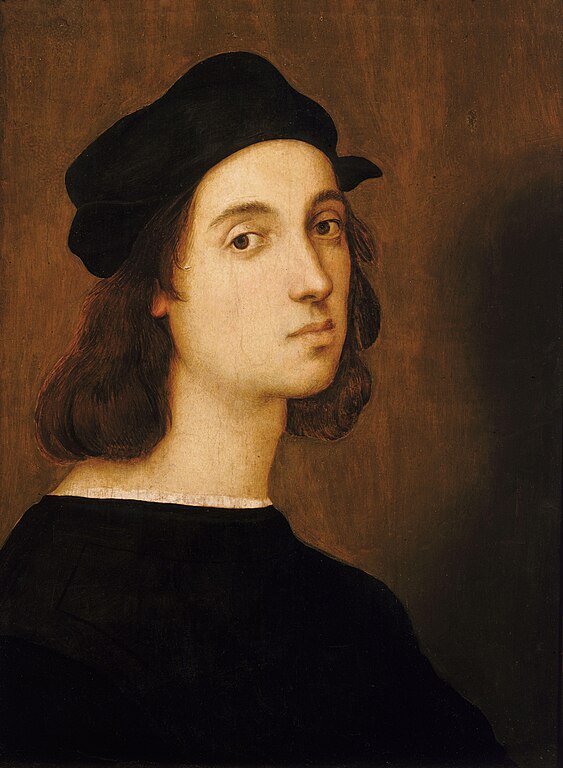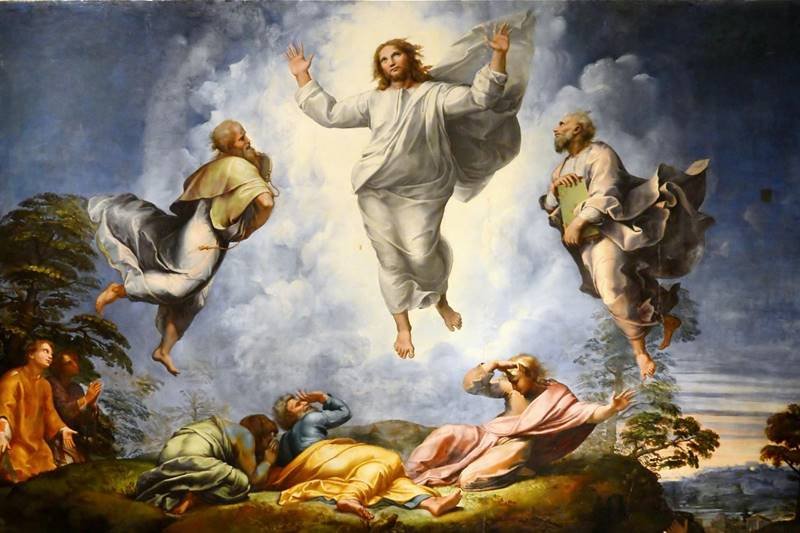Raphael’s Transfiguration is an iconic masterpiece that captures the artist’s unparalleled skill in composition, color, and storytelling. As his final work, this painting encapsulates the spiritual and artistic depth that defined the High Renaissance.
Commissioned by then Cardinal Giulio de’ Medici (later, Pope Leo X) in 1516, The Transfiguration was intended as an altarpiece for the Narbonne Cathedral in France but remained in Rome after Raphael’s death.
The painting seamlessly combines two narratives, portraying both the divine glory of Christ and the human struggles of his apostles, making it a profoundly moving and complex work of art.
About Raphael Sanzio

Raphael Sanzio (1483–1520), one of the great masters of the High Renaissance, is celebrated for his harmonious compositions, lifelike figures, and innovative use of space and perspective. Born in Urbino, Italy, Raphael studied under Pietro Perugino and was later influenced by Leonardo da Vinci and Michelangelo during his time in Florence.
His work in Rome for Popes Julius II and Leo X solidified his reputation as a master painter and architect. Despite his untimely death at the age of 37, Raphael left an enduring legacy through his works, including the Raphael Rooms and numerous altarpieces, portraits, and frescoes.
About the Painting The Transfiguration

The Transfiguration was painted between 1516 and 1520, with Raphael working on it until his death. The composition is divided into two distinct yet interconnected scenes. The upper half portrays the divine transfiguration of Christ on Mount Tabor.
Christ is depicted in radiant glory, surrounded by a luminous aura, with Moses to his right and Elijah to his left, representing the fulfillment of Old Testament prophecies. The trio of disciples below—Peter, James, and John—lie prostrate in awe and terror, their postures emphasizing their human limitations in comprehending divine revelation. Raphael’s use of light in this section is masterful, with a heavenly glow that transcends the canvas, symbolizing Christ’s divine nature and the connection between heaven and earth.
The lower half of the painting presents a stark contrast, showing the apostles struggling to heal a possessed boy. The boy, contorted and anguished, is held by his desperate father, while figures on either side gesture dramatically, pleading for help. The mother’s sorrowful gaze and clasped hands add to the emotional intensity of the scene. The chaos and darkness in the lower half reflect the turmoil and suffering of humanity, contrasting sharply with the serenity and light of the upper scene. The two parts are connected through the gestures of the figures, directing the viewer’s attention upward to Christ as the ultimate source of hope and salvation.
Raphael’s composition employs a diagonal structure that guides the viewer’s eye seamlessly from the earthly struggles below to the divine revelation above. This structure emphasizes the interconnectedness of the spiritual and earthly realms, reinforcing the painting’s central theme of faith and redemption. The vibrant colors, precise anatomy, and emotional depth of the figures further demonstrate Raphael’s unparalleled mastery.
The painting also includes subtle details that enhance its narrative complexity. For instance, the apostles in the lower half display a mix of confusion and determination, underscoring the challenges of faith when confronted with human suffering. The gestures of the crowd create a dynamic rhythm, contrasting with the stillness of the transfigured Christ, whose presence remains unshaken amid the surrounding turmoil. These intricate elements make The Transfiguration not only a visual marvel but also a profound meditation on the duality of human existence and divine grace.
History and Significance of Transfiguration
Commissioned by Cardinal Giulio de’ Medici, The Transfiguration was intended to inspire devotion and awe among the faithful. After Raphael’s death, the painting was displayed at his funeral as a testament to his artistic genius. It later became part of the Vatican’s collection and is now considered one of the greatest masterpieces of the Renaissance. The painting’s innovative composition and profound themes influenced generations of artists, solidifying Raphael’s status as a pivotal figure in art history.
Where to See It
Today, The Transfiguration is housed in the Pinacoteca Vaticana, part of the Vatican Museums. Its prominent placement allows visitors to fully appreciate its grandeur and intricate details. The painting remains a focal point of the gallery, drawing countless admirers from around the world who seek to experience Raphael’s final and most ambitious work.
Visitor Tips
To fully appreciate The Transfiguration, visit the Pinacoteca Vaticana during quieter hours, such as early morning or late afternoon. Take time to study the intricate details of both the upper and lower sections, noting Raphael’s exceptional ability to convey emotion and movement.
Consider using an audio guide or joining a tour to gain deeper insights into the historical and artistic context of the painting. The Transfiguration is a must-see for anyone visiting the Vatican Museums, offering a profound encounter with one of the greatest works of art ever created.
More to Discover at Vatican Museums:
- The Intriguing Gregorian Etruscan Museum
- The Iconic Giuseppe Momo Staircase of the Vatican Museums
- Da Vinci’s Saint Jerome in the Wilderness

